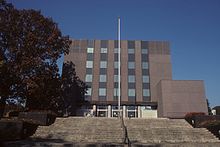User:JPRiley/MGSmith
| This is not a Wikipedia article: It is an individual user's work-in-progress page, and may be incomplete and/or unreliable. For guidance on developing this draft, see Wikipedia:So you made a userspace draft. Find sources: Google (books · news · scholar · free images · WP refs) · FENS · JSTOR · TWL |
Moreland Griffith Smith | |
|---|---|
| Born | December 15, 1906 |
| Died | June 26, 1989 (aged 82) |
| Nationality | American |
| Occupation | Architect |
| Practice | Sherlock, Smith & Adams |



Moreland Griffith Smith FAIA (1906–1989) was an American architect and civil rights activist. Smith practiced architecture in Montgomery, Alabama from 1946 to 1965.
Life and career[edit]
Moreland Griffith Smith was born December 15, 1906 in Adrian, Michigan. He was educated at Auburn University, Fontainebleau and the Massachusetts Institute of Technology, graduating from the latter in 1933 with an MArch. That same year he opened an architects office in Montgomery, Alabama, which he would maintain until the outbreak of World War II. His most significant work from this period is the Greenville City Hall, completed in 1937. He served in the United States Army Corps of Engineers from 1942 to 1945, and in 1946 returned to Montgomery where, in partnership with engineer Chris J. Sherlock and architect Richard J. Adams, he formed the firm of Sherlock, Smith & Adams, architects and engineers.
A consistent advocate for Black architects, Smith became involved in the civil rights movement in 1954 when he unsuccessfully encouraged Montgomery major W. A. Gayle to end segregated bus services in Montgomery prior to the Montgomery bus boycott. He served on the board of trustees of the Tuskegee Institute beginning in 1957 and was chair of the institute's board and grounds committee from 1958 to 1960. In this capacity Smith oversaw the commissioning and construction of the Tuskegee chapel, which at his urging was designed by Paul Rudolph in association with Fry & Welch, a well-known Black-owned architecture firm based in Washington, D.C. Smith's consistent advocacy eventually drew the ire of segregationist Alabama governor George Wallace. In a memoir, Smith's wife later wrote that:
“One day, Union Bank and Trust President John Neill, called in Moreland, who served on the bank’s board of directors. He told Moreland that Gov. George Wallace had said the state (of Alabama) would give the bank no more business unless they cut off Moreland’s credit. Moreland realized this was a turning point, that he could not run his business without credit. His young associates had become increasingly concerned and were only too glad to buy the business when it was offered to them.”
Smith sold his interest in Sherlock, Smith & Adams in 1965 and moved to Atlanta. In Atlanta Smith maintained a consulting practice for some twenty years and was a member of the staff of the Southern Regional Council.
Smith joined the American Institute of Architects in 1933 and served as Montgomery chapter president in 1937 and 1957. He was elected a Fellow in 1961. In 1987 the Atlanta chapter honored him for his work during the early years of the civil rights movement.
Personal life[edit]
Smith was married in
Architectural works[edit]
- St. Andrew Episcopal Church, 701 W Montgomery Rd, Tuskegee, Alabama (1949)
- Garrett Coliseum (1948–53)
- DeKalb County Courthouse, 200 Grand Ave, Fort Payne, Alabama (1949–50, altered 1999–2000)
- Monroe County Courthouse, 65 N Monroe St, Monroeville, Alabama (1962–63)
- Geneva County Courthouse, 200 N Commerce St, Geneva, Alabama (1964–65)
- https://aiahistoricaldirectory.atlassian.net/wiki/spaces/AHDAA/pages/37068823/ahd1041902
- https://www.ssainc.com/history/
- https://www.ssainc.com/founder-moreland-smith-and-tuskegee-chapel/
- https://www.ssainc.com/daughter-of-ssa-founder-moreland-smith-stops-by-for-a-visit/
- https://archive.org/details/chronologyofafri00horn/page/394/mode/2up?q=%22moreland+griffith+smith%22
- https://archive.org/details/MIT-Technology-Review-1990-01/page/n69/mode/2up?q=%22moreland+griffith+smith%22
- https://www.legacy.com/us/obituaries/atlanta/name/marjorie-smith-obituary?id=13076093
- https://www.thecolumbiastar.com/articles/columbia-psychologist-inspired-by-her-parents-stand-for-civil-rights/

